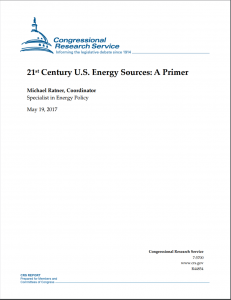Full Title: 21st Century U.S. Energy Sources: A Primer
Author(s): Michael Ratner
Publisher(s): Congressional Research Service
Publication Date: May 1, 2017
Full Text: Download Resource
Description (excerpt):
Since the start of the 21st century, the U.S. energy system has seen tremendous changes.
Technological advances in energy production have driven changes in energy consumption, and
the United States has moved from being a growing net importer of most forms of energy to a
declining importer—and possibly a net exporter in the near future. The United States remains the
second largest consumer of energy in the world, behind China.
The U.S. oil and natural gas industry has gone through a “renaissance” of production.
Technological improvements in hydraulic fracturing and horizontal drilling have unlocked
enormous oil and natural gas resources from tight formations, such as shale. Oil has reached a
level of production not seen in decades, and is projected to surpass the previous peaks of the early
1970s. Natural gas has set new production records almost every year since 2000. In conjunction
with the rise in oil and natural gas production, U.S. production of natural gas liquids has also
increased. The rise in production of these fuel sources has also corresponded with increased
consumption and exports of each.
The rise in U.S. oil and natural gas production has taken place mostly onshore and on nonfederal
lands. Nonfederal crude oil production nearly doubled over the past decade. While production on
federal land has increased, it has not grown as fast as nonfederal oil production, causing the
federal share of total U.S. crude oil production to fall from its peak of nearly 36% in 2009 to
about 22% in 2015 (the latest data available). U.S natural gas production shifted even more
dramatically, with total U.S. production nearly doubling since 2006, while production on federal
lands declined by almost 26% over the same time period. The federal share decreased from 28%
in 2006 to 15% in 2015.
The electric power industry is in the process of transformation, especially with natural gas
becoming the main electric generation fuel in 2016 and the growth in renewable forms of energy.
The electricity infrastructure of the United States is aging. Uncertainty exists about how to
modernize the grid and what technologies and fuels will be used to produce electricity in the
future. Unresolved questions about transmission and reliability of the grid are arising due to
potential cybersecurity threats and continuing interest in renewable energy and other low carbon
sources of electricity. Concerns about reliability and electricity prices are complicated by
environmental regulations and the rising availability of natural gas for electric power production.
While renewable energy is currently a relatively small portion of the total U.S. energy sector,
renewables production and consumption have increased since the turn of this century. As a source
of total primary energy, renewable energy increased 97% between 2001 and 2016. Unlike some
other energy commodities (e.g., crude oil), renewable energy is available in a variety of distinct
forms that use different conversion technologies to produce usable energy products (e.g.,
electricity, heat, and liquid fuels). Therefore, it is important to distinguish between renewable fuel
sources and uses.
The United States has the largest coal resources in the world. Coal is used primarily for electricity
generation. Although its prices have stayed low, coal has faced increasing competition from
natural gas and renewables. U.S. consumption peaked in 2007 and has since declined by 35%.
Meanwhile, nuclear output has stayed flat during the time period, but has faced significant stress
as a future source of electric power generation.
Energy production and consumption have been issues of interest to Congress for decades. Current
topics of concern to Congress include exports, imports, independence, security, infrastructure,
efficiency, the environment, and geopolitics. Legislation has been introduced in both houses of
Congress to address these issues and others
